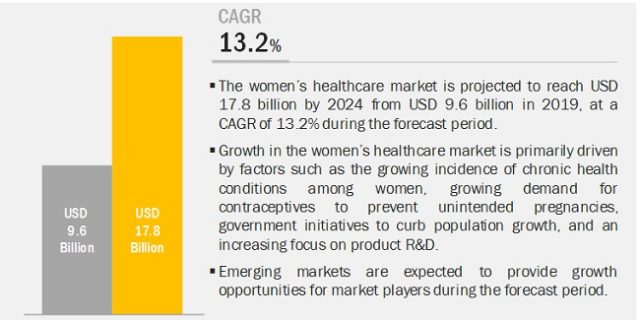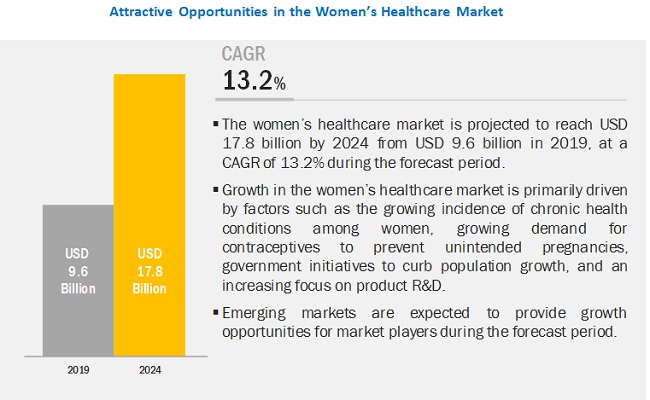
The Womens HealthCare Market growth is primarily driven by factors such as the growing incidence of chronic health conditions among women, government initiatives to curb population growth, and growing demand for contraceptives to prevent unintended pregnancies. Moreover, the growing focus on R&D by key players for the development of advanced products is also a major factor in driving growth.
The research study involved four major activities in estimating the current size of the global women’s healthcare market. Exhaustive secondary research was conducted to collect information on the market, its peer markets, and its parent market. The next step was to validate these findings, assumptions, and sizing values with industry experts across the value chain through primary research. Both top-down and bottom-up approaches were employed to estimate the total market size.
Women’s HealthCare Market Size Estimation;
Both top-down and bottom-up approaches were used to estimate and validate the total size of the market. These methods were also used extensively to determine the size of various sub-segments in the market. The research methodology used to estimate the market size includes the following:
– The key players in the industry and markets have been identified through extensive secondary research
– The revenue generated from the sales of respective products from the respective geographies in the market by leading players were aggregated to get the market value for individual products at the global level. The global market values obtained for each product were added together to get the total global market value for the market.
– All percentage shares, splits, and breakdowns have been determined using secondary sources and verified through primary sources
Download PDF Brochure:
https://www.marketsandmarkets.com/pdfdownloadNew.asp?id=136585329

Geographically; North America was the largest and the fastest-growing regional market for women’s healthcare. The increasing median age of first-time pregnancies and the growing prevalence of PCOS and postmenopausal osteoporosis are the factors responsible for the growth of this regional segment. Furthermore, the growing awareness and understanding regarding contraceptives among American women, easy access to modern contraception as compared to developing countries, and increased healthcare spending also support the growth of this market.
The prominent players in the global Women’s Health Care Market include Bayer AG (Germany), Allergan (Dublin), Merck & Co. (US), Pfizer Inc. (US), Amgen (US), Agile Therapeutics Inc. (US), Ferring Pharmaceuticals (US), Mylan N.V. (US), Lupin (India), Blairex Laboratories (US), Apothecus Pharmaceutical (US), Eli Lilly And Company (US), Novartis AG (Switzerland), and Johnson & Johnson (US).
Amgen (US) is one of the leading providers of the women’s healthcare market. The company’s sales and marketing activities are greatly focused on the US and Europe. The company provides Prolia and Xgeva for the treatment of osteoporosis in postmenopausal women. These drugs have shown a year-on-year double-digit value gain as well as volume growth, and constitute the largest share of the women’s healthcare market. Amgen’s EVENITY, meant for the treatment of osteoporosis in postmenopausal women, is also in phase 3 of development. It is being developed in collaboration with UCB (Belgium). The company’s high brand recognition and focus on product innovation have helped it to maintain its foothold in the market.
Request Sample Pages:
https://www.marketsandmarkets.com/requestsampleNew.asp?id=136585329
Prolia is the largest and fastest-growing segment of the market.
Based on drug, the women’s health care market is segmented into EVISTA, XGEVA, Prolia, Mirena, Zometa, Reclast/Aclasta, Minastrin 24 Fe, NuvaRing, FORTEO, Premarin, ACTONEL, and ORTHO-TRI-CY LO (28). Prolia is the largest and fastest-growing segment of the market. Prolia has shown a considerable year-on-year growth primarily due to increasing unit demand. Prolia has witnessed positive market growth owing to the increasing prevalence of postmenopausal osteoporosis in the US.


